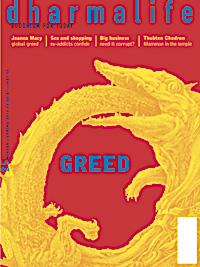Sky Burial
An epic story of Tibet from the author of The Good Women of China
Author: Xinran
Chatto & Windus 2004, £14.99 h/b
Sky Burial recounts the true story of a Chinese woman, Wen, who travelled to Tibet in 1958 searching for her lost husband. At that time even Chinese people had no knowledge of Tibet and the book, like Wen herself, uncovers Tibetan culture. Xinran, who interviewed Wen in the early 1990s, tells her story with sensitivity and authority and Wen's determination to find her husband seizes the reader's attention.
Wen joined the Chinese army in order to gain entry to Tibet and is helped by surprisingly kindly army officers who are impressed by her feelings for her husband. First published in China, the book does not mention abuses by the Chinese army nor the political nature of the conflict. Religion and politics are simply the backdrop to Wen's personal journey - a saga of love and friendship.
Following an accident, Wen is cared for by a nomadic family and she stays with them for almost 30 years - it's not clear why. Living in the far North of Tibet without electricity, mechanical tools or news of the outside world, they did not know that the Chinese army were in their country, and she did not tell them; but Wen's naiveté allowed her to discover her spirituality unencumbered by self-consciousness. Her mission was to find her husband but profound elements of Buddhism gradually seeped into her life, as when she encountered the tradition of carving scriptures onto rocks as offerings:
'It was at the ninth mountain that they found Zhouma's message. The mountain was covered with pile upon pile of mani stones inscribed with the mani mantra and passages of Buddhist scripture.
' "They are the Diamond Sutra," said Tiananmen. "There is one chapter of scripture to each cairn."
'... As Wen gazed at them, she tried in vain to imagine how many generations of hands had carved those holy words, piling them up on this mountain to be preserved for thousands of years.'
Wen eventually discovers that her husband died many years earlier and returns to China in the mid-1990s. But finding that her town has been rebuilt three times and her family has vanished, Wen realises how much the world has changed and how much Tibet has changed her.
The book opens a window onto a world where patience, perseverance, and faith have a strength rarely seen in the West: where half a lead pencil was a monastery's most prized (and modern) possession, where people spent years looking for one another, weeks crossing a single mountain pass, and daily life was saturated with the spirits of Mahayana Buddhism. With these fairytale qualities, it was hard to credit the book's authenticity.
But at the end is an open letter by the author pleading for Wen to contact her because, after her impromptu interview, she never saw Wen again.
Erin Ferguson


